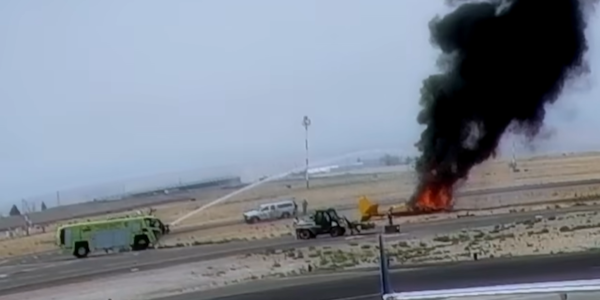NTSB releases final report on Dale Snodgrass crash

Famed airshow pilot Dale Snodgrass departed from the Lewiston-Nez Perce Airport (LWS) in his SIAI Marchetti SM-10198 aircraft, which collided with terrain shortly after takeoff, killing Snodgrass. According to the NTSB final report released this week, the July 2021 crash was caused by the pilot’s failure to remove the flight control lock before takeoff.
The report noted that the cabin floor, where the control lock tube should have been mounted for flight, was severely deformed and compressed. If the lock had been stowed during impact, it would have been pinned under the flight control stick and the retaining clip would have been deformed. “However, the control lock and its retaining clip were essentially undamaged and the lock was found raised off the floor,” said the report. This information means it is likely the control lock was installed on the flight control stick during takeoff and impact.
Investigators also reviewed high-resolution security camera footage of the accident, which revealed “no discernable movement of the elevators or ailerons.”
The control lock is painted red to provide pilots a visual reminder to assess the lock during preflight checks, a pilot owning a similar aircraft told the NTSB that he had once become distracted during preflight checks and was able to taxi, initiate takeoff, and become airborne with the control lock engaged. “He stated that, once he realized his mistake, removal of the lock was a struggle due to the forces imposed on the control stick during takeoff.”
The pitch trim was also found in an almost full nose-down position, which suggests that the pilot may have been attempting to use the trim to stop the aircraft’s increasing nose-up altitude caused by the locked control stick. “Whether the pilot recognized that the control lock was engaged or believed he had a flight control problem could not be determined. Regardless, after takeoff during a dynamic and transitional phase of flight, there would have been minimal time to accurately diagnose the issue and disconnect the control lock,” noted the report.
“The intended purpose and destination of the flight was routine and there was no apparent time pressure present. The pilot was reported to be extremely thorough about performing preflight checks, and according to his wife, the expected duration of his normal preflight activities would not have allowed him to depart when he did. The pilot had limited experience in the accident airplane, which could explain why he did not remove the control lock during the preflight inspection,” said the NTSB. “While omission of the control check is consistent with a pilot rushing or distracted, and the short duration from taxi to takeoff would have reduced this pilot’s opportunity to detect his error, the investigation was not able to determine the reason it was not performed.”
During the pilot’s autopsy, examiners noticed the presence of heart disease, which would pose an increased risk of an incapacitating cardiac event, however, it is unlikely it caused the pilot to become distracted. The pilot was also not incapacitated by a cardiac event as his final radio transmission showed he was aware and speaking before the loss of control.
Snodgrass was a retired Captain from the United States Navy, serving for 26 years, most notably as an F-18 Tomcat pilot for over a decade.

Recent Comments